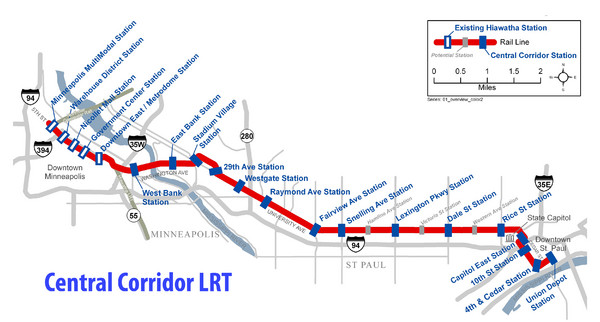The Central Corridor Project that will connect the St. Paul and
Minneapolis downtown areas is another step officials are taking to incorporate
light rails into the Twin Cities metro area. Officials hope the light
rail will improve mobility throughout the metro, reduce road congestion and
increase economic growth and development in the area. Even though many were
enthusiastic about the project, it was not without its challenges.
Such a massive project required the support and funding of multiple
governments and private groups alike. There were many political hurdles to
clear on the path to secure funding for this project just at the state level.
Competition for federal funding, necessary for the project to even happen, is
especially fierce with projects from across the nation competing for those
funds. It is a very long, arduous process where specific cost-effectiveness,
environmental, and safety standards needed to be met before even being
considered for Federal funds.
There were also administrative constraints with community stakeholders
along the route of the light rail. Between concerns over parking, access to
businesses, busing reductions and construction effects, the Met Council had
plenty on its plate.
The University of Minnesota presented significant challenges as well,
and being a large enough stakeholder they were able to alter the construction of the rails
through campus in order to prevent negative externalities, vibrations and other interference, to nearby research
facilities that might be caused by the light rail.
Another major challenge surrounded Washington Avenue Bridge. Hennepin
County was already preparing to repair the bridge in the wake of the I-35W
collapse, and now the bridge would need additional fortification to support
light rail cars traveling across it. Met Council, being in charge of the light
rail and Hennepin County in charge of repairs to the pedestrian level of the
bridge, had to coordinate plans every step of the way to ensure that any
repairs to the bridge would not hamper the plans of the light rail project.
Met Council was able to overcome these constraints and construction of
the light rail is on pace to be completed on time in 2014. They hope to
recreate the positive outcomes seen in the Hiawatha light rail line completed
in 2004.
Once completed officials’ estimate that the Central Corridor will provide
workers access to nearly 280,000 jobs along the route, and by 2030 the line
will provide access to about 345,000 jobs.

No comments:
Post a Comment